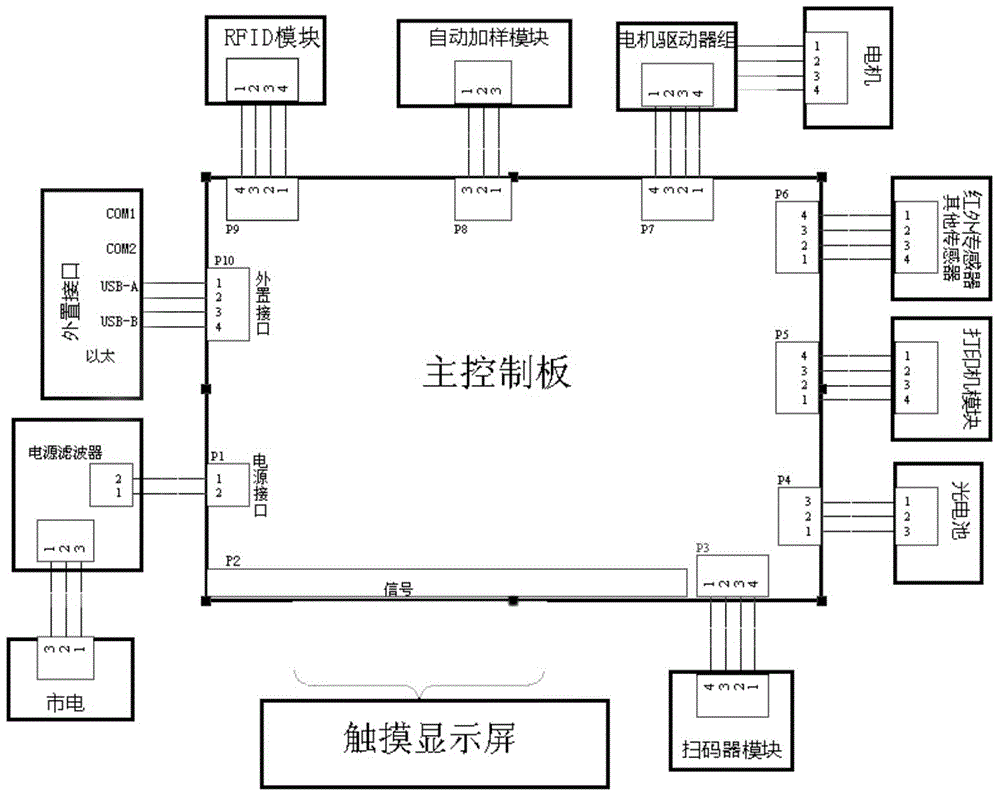Full-automatic immuno-fluorescence quantitative analysis device and implementation method
A quantitative analysis and fluorescence immunoassay technology, which is applied in the field of quantitative fluorescence immunoassay detection, can solve the problems of increasing manual intervention test errors, inaccurate sampling accuracy, and delaying disease diagnosis, so as to realize automated testing, reduce human errors, and improve The effect of precision
- Summary
- Abstract
- Description
- Claims
- Application Information
AI Technical Summary
Problems solved by technology
Method used
Image
Examples
Embodiment 1
[0050] Such as figure 2 , 3 , 4, a fully automatic fluorescent immunoassay analysis device, including a support base plate 1 and a control system, and also includes a reagent strip storage and automatic loading module 3, a reaction disk module 4, a detection module 5, and a sample array arranged in sequence on the base plate Module 6, sampling module 7 and washing module 8; reagent strip storage and automatic loading device 3 provides reagent strips for the reaction disk module 4, and the sample loading module 7 adds the sample in the sample module 6 to the reagent strip of the reaction disk module 4 Carry out the reaction, and enter the detection module 5 after completing the reaction to complete the detection.
[0051] Such as figure 2 , 4 As shown, the sample adding module 7 includes an XYZ moving mechanical arm and a disposable suction head picker 12; the X arm 9 is arranged horizontally and can be located at the top of the circuit box 2, and the Y arm 10 is located a...
Embodiment 2
[0062] A fully automatic fluorescent immunoassay quantitative analysis device, the specific structure of the reagent strip storage and automatic loading module 3 and the supporting reaction disk module 4 is as follows, and the other modules are similar in structure to the embodiment 1.
[0063] Such as Figure 6 As shown, the reaction disk module 4 is a disk-shaped device, and a plurality of reagent strip slots 26 are fixed on the edge of the disk, and the slot openings correspond to the positions of the reagent strip outlets 27, as shown in FIG. Figure 7 As shown, there is a gap 28 in the middle of the lower bottom surface of the reagent strip slot 26, and the gap 28 allows the elastic hanging rod 38 to send the reagent strip into the reagent strip slot 26; the lower part of the reaction tray module 4 passes through the base plate and the first motor at the bottom of the base plate 29, the first motor 29 is connected to the control system, and the control system drives the f...
Embodiment 3
[0076] A fully automatic fluorescent immunoassay quantitative analysis device, the detection module 5 is provided with elastic hooks, and the structure of other modules is similar to that of embodiment 2.
[0077] After the detection module 5 completes the detection of the reagent strip, the elastic hook under the detection module 5 pushes the reagent strip out of the reaction tray and enters under the detection device. After the detection of the next reagent strip is completed, the previous reagent strip is pushed out of the device of this embodiment by the next reagent strip, and the next reagent strip remains under the detection device.
PUM
 Login to View More
Login to View More Abstract
Description
Claims
Application Information
 Login to View More
Login to View More - R&D
- Intellectual Property
- Life Sciences
- Materials
- Tech Scout
- Unparalleled Data Quality
- Higher Quality Content
- 60% Fewer Hallucinations
Browse by: Latest US Patents, China's latest patents, Technical Efficacy Thesaurus, Application Domain, Technology Topic, Popular Technical Reports.
© 2025 PatSnap. All rights reserved.Legal|Privacy policy|Modern Slavery Act Transparency Statement|Sitemap|About US| Contact US: help@patsnap.com



